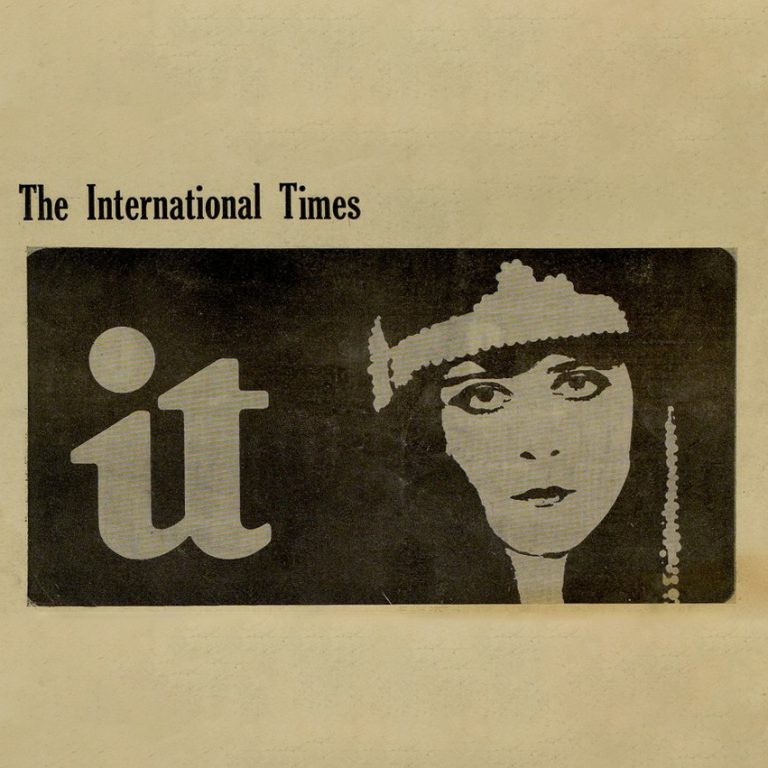
Saturday, October 15, 1966
Paul McCartney attends the opening night celebration for “International Times”
Last updated on May 9, 2024

Saturday, October 15, 1966
Last updated on May 9, 2024
Location: Roundhouse, London, UK
Interview October 1966 • The Beatles interview for The Beatles Monthly Book
Article October 1966 • Paul McCartney meets Yoko Ono
Article Oct 15, 1966 • Paul McCartney attends the opening night celebration for "International Times"
Single Oct 22, 1966 • "Mellow Yellow / Sunny South Kensington" by Donovan released in the US
Article Oct 25, 1966 • The Jimi Hendrix Experience plays a private showcase at the Scotch Of St James Club
International Times, also known as “it” or “IT”, was an underground newspaper that officially launched on this day with a huge party at the Roundhouse in London. This was one of the first big gigs for Pink Floyd and Soft Machine.
International Times was co-founded by Barry Miles, a friend of Paul McCartney, who also created the Indica bookstore. Paul joined the celebration, disguised in an Arabian costume. Other attendees included Mick Jagger and Marianne Faithful, Yoko Ono, filmmaker Michelangelo Antonioni, and record producer Mickie Most.
Paul was interviewed by Barry Miles in the January 1967 issue of International Times.
It’s something I realise l didn’t put around a lot at the time, like l helped start International Times with Miles, helped start Indica Bookshop and Gallery where John met Yoko. Was big buddies with Robert Fraser and was very into Magritte. So I had a very rich avant-garde period which was such a buzz, making movies and stuff. Because I was living on my own in London, and all the other guys were married in the suburbs, they were very square in my mind, and they’d come in, and come into my pad where there’d be people all hanging out and weird sculptures and stuff and I’d be making, piecing together little films and stuff.
Paul McCartney – From “The Paul McCartney World Tour” book – 1989
From “Lost In The Woods – Syd Barrett and the Pink Floyd” by Julian Palacio, 2001:
On 15 October the new underground newspaper the International Times or simply ‘It’, as it came to be known, was launched on a cold night with a huge event at the Roundhouse in Chalk Farm, London. Miles: ‘We did fliers for the IT launch to publicise it, printed on letterpress, with the actual IT girl on it, Clara Bow. We printed thousands and gave them away or mailed them to people.‘ Using Hoppy’s address book, Miles and Hoppy sent out invitations that circulated among the hip coteries of the emerging underground.
It promised a ‘Pop/Op/Costume/Masque/Fantasy-Loon/Blowout/Drag Ball. All night rave to launch International Times, with the Soft Machine, Pink Floyd, steel bands, strips, trips, happenings, movies. Bring your own poison and flowers & gas filled balloons & submarines & rocket ships & candy & striped boxes & ladders & paint & flutes & feet & ladders & locomotives & madness & autumn & blow lamps.‘ Perhaps 99% of today’s estimated million a week club goers in the UK don’t know about this milestone event, the very first rave, paving the way for all that came later.
Miles stood at the top of the staircase that curved around the brick facade of the Roundhouse, greeting each guest with a sugar cube, which was assumed to contain LSD. They didn’t, but there was plenty on offer inside, dispensed by the new street pharmacists who congregated by the thin, fluted steel pillars inside the Roundhouse and sold them or gave them away.
Miles said, ‘The Roundhouse was a complete fire trap. It hadn’t been used since before the war. The balcony was completely unsafe, Gilbey’s Gin used it as a store. It hadn’t been used since the turn of the century. In fact it was never used as a roundhouse for locomotives, it was for the winding gear to pull the trains up hill from Euston Station and once steam power was strong enough, it became redundant. It was grimy and very, very cold, cos it was October. We had the Pink Floyd and the Soft Machine. It was the first big gig for both of them.‘
Hoppy says, ‘The Roundhouse was very cold. Arnold Wesker was a playwright who came to prominence in the late 1950s and early 1960s. And he considered himself a socialist. He made a successful interaction with the trade union movement; ‘art for the masses’. And he set up Centre 42, which was based on the Trade Union manifesto, section 42. His main interest was theatre and theatre is a very difficult art form to propagate to the masses at anytime, even then. He was on a roll and he managed to persuade the Gilbey’s Gin company to let him take over the Roundhouse. He wasn’t able to materialise his vision of the Roundhouse as a trade union people’ cultural theatre. I worked for Wesker as a photographer, taking pictures of the Roundhouse, when it was still as gin vat warehouse. Although Centre 42 had acquired the Roundhouse, he didn’t do anything with it. I said, ‘Arnold, look, here’s 50 pounds, let us use the Roundhouse.’ He didn’t participate, he was in a different space altogether. He was serious, probably still is!’
Joe Boyd notes the role of the event, ‘The underground spirit was made manifest at the London Free School concerts, and the IT launch.‘ Horace Ove, an actor, said, ‘I remember Peter Jenner and his wife getting ready for a show at the Roundhouse and they were actually cleaning up the Pink Floyd and combing their hair, like kids. And that’s when the whole psychedelic period started. The Floyd playing the All Saints Hall and so on. Light shows.’ Miles says, ‘The giant six foot jelly at the IT launch was a classic English thing, ‘We’re having a party, let’s make a great big jelly!’ So she did. The one at the launch was made out of a bath. The Pink Floyd backed their van into it and knocked it over. But Steve Abrams said it never set, it was still sloshy, and it was jelling on a big plastic sheet so when it was done one could pull it out. But Steve said that it the bath was being held up by wooden supports and Syd and Pip Carter pulled away some of the wood to use for their light show, and the whole thing collapsed, splashing jelly everywhere. There was body painting, Mike Westbrook did an imitation of Yves Klein. He got naked and covered himself in paint and crawled along a sheet of wall paper. I paid the Soft Machine 12 pounds ten shilling and 15 pounds to the Pink Floyd, because they had a light show. The Soft Machine, however, did have a motorcycle on which they had contact mikes, and which they gave people rides on.’
The New Society reported that Marianne Faithful ‘was wearing what appeared to be a fair imitation of a nun’s habit, which didn’t quite make it to the ground: in fact it didn’t even cover her bottom; this must have been the shortest of the evening, if not the barest.‘ Kenneth Rexroth, the American forefather of the Beats, filed the following report for the December 4, 1966 San Francisco Examiner under the headline ‘Making the Rounds of Way-Out London‘. ‘The bands didn’t show, so there was a large pick-up band of assorted instruments on a small central platform. Sometimes they were making rhythmic sounds, sometimes not….I felt exactly like I was on the Titanic. Far be it for me to holler copper, but I was dumbfounded that the London police and fire authorities permitted even a dozen people to congregate in such a trap.‘
Peter Jenner said, ‘Paul McCartney was, dressed as an arab in a hood. It was very dark. The total power supply in the Roundhouse at that time was about as much as there was in the average kitchen, probably much less. So the Floyd frequently put all the lights out; we frequently blew the power. If you saw the place in daylight you would have been horrified. It was dank, really cold and wet and filthy and horrible but the excitement at that gig was enormous. It was like ‘Wow! This is our place.’ There was this great feeling; it was a classic gig, a terrific gig, and there was the Floyd and there was the Soft Machine.’ […]
Daevid Allen of the Soft Machine called the launch ‘one of the two most revolutionary events in the history of English alternative music and thinking. The IT event was important because it marked the first recognition of a rapidly spreading socio-cultural revolution that had its parallel in the States. It was its London newspaper. The new year came…bringing and inexpressible feeling of change in the air.‘ Allen noted that two separate stages had been set up and facing was the first light show gantry seen in London. All around milled the crowd in their ‘fancy dress’.
The Soft Machine played their first gig as a quartet, going on at 9 PM. They had borrowed a motorcycle, parked it onstage and fitted it with contact mikes on the cylinder head, and its short bursts of noises as it was revved echoes throughout the Roundhouse at intervals through their performance of their psychedelic-laced jazz improvisations. Halfway through their set, all the lights were shut off, and in the darkness came the amplified voice of a Japanese woman. It was Yoko Ono, staging a Fluxus-style Happening.
‘Touch the person next to you…..‘ she said, and the startled audience responded, reaching in the dark for the person next to them. A flurry of embarrassed giggles and then the lights came back on and the Soft Machine continued their set. Ono, who had been active in the German/American experimental arts movement Fluxus in the early 1960’s, was a familiar figure in the nascent Underground. On November 9th, just a few weeks away, she would meet John Lennon at Miles and John Dunbar’s Indica Art Gallery. Lennon had come down to see her ‘Unfinished Objects and Paintings’ show. ‘Yoko One came around to Cromwell Road,’ says painter Duggie Fields, ‘she wanted me be in her ‘Bottoms’ movie which I found uninteresting. Now I wish I’d gone and talked to Yoko when she came to Cromwell, even had my bottom filmed, because she was a very interesting woman.‘ Keith Rowe of AMM says, ‘We had a very good relationship with Yoko. She used to stay at Cornelius Cardew’s flat, and the AMM played at the opening of her exhibition. We knew her quite well.‘ Not everyone felt the same enthusiasm; Hoppy remarks, ‘Yoko Ono’s Happenings were boring, she was the most boring artist I’d ever met.’
As the Soft Machine finished, the Pink Floyd began their set on the stage set up on the opposite side of the Roundhouse. With the house lights off and their light show on, Barrett & Co. began with the low, ominous rumble of ‘Astronomy Domine’. Their light show, though appallingly primitive, made quite an impression of the assembled crowd, not least of all Paul McCartney, who made his approval plain.
On October 30 The Sunday Times wrote, ‘At the launching of the new magazine IT the other night a pop group called the Pink Floyd played throbbing music while a series of bizarre coloured shapes flashed on a huge screen behind them. Someone had made a mountain of jelly which people ate at midnight and another person had parked his motorbike in the middle of the room. All apparently very psychedelic.’
From “Lost In The Woods – Syd Barrett and the Pink Floyd” by Julian Palacio, 2001
2500 Ball at IT-Launch
It isn’t so cool to rave about your own party, but the IT Rave-Up at the Roundhouse two Saturday ago was such an event we decided it merited an IT report. It was mainly atmospherics: two and half thousand people dancing about in that strange, giant round barn. Darkness, only flashing lights. People in masks, girls half-naked. Other people standing about wondering what the hell was going on. Pot smoke. Now and then the sound of a bottle breaking. Somebody looks as if he might get violent. There was a lot of tension about. Plus the specifics:
The Pink Floyd, psychedelic pop group, did weird things to the feel of the event with their scary feedback sounds, slide projections playing on their skin (drops of paint run riot on the slides to produce outer space, prehistoric textures on the skin), spotlights flashing on them in time with a drum beat… more about them next issue.
The Soft Machine, another group with new ideas, drove a motorbike into the place, in and around the pillars that held up that gallery we had been warned wasn’t all that safe… more about them too.
A large car (some said it was an Oldsmobile, others a Cadillac) in the middle of it all, painted bright pop art stripes and explosions, by Binder, Edwards and Vaughan. New York Interior decorators who, someone said, put stripes over everything. Car was previously seen parked inside the Robert Fraser Gallery. Apparently, the group has a jukebox on show and in action in the Golden Egg on the Strand.
Simon Postuma and Marijke Koger, the Amsterdam couple who are opening Karma (see Miles’ column last issue), designed an interesting cubicle with coloured screens and nets, and within the box one of them, in suitable dress, read palms and told fortunes.
In another part of the Roundhouse, Bob Cobbing and the London Film Coop gave an all-night film show, featuring films like Scorpio Rising, Towers Open Fire, under the most difficult of conditions. The audience stood in front of the projectors, on top of the cables, on top of Bob Cobbing. Yet the films went on. It may, though, have been just the right setting for those particular films. Burroughs’ inner space disappearance in Towers Open Fire somehow had more impact because of the vibrations from the “party”.
“Famous” people turned up: Antonioni and Monica Vitti, Paul McCartney disguised as an arab, Kenneth Rexroth, Peter Brook, Mickey Most and Tony Secunda. We also saw a well-known junkie, a notorious homosexual, and many happy people who were only known to their friends but who the hell cares in a scene like that anyway?
Of course several things went wrong. There was that narrow entrance for an unpleasant start. That communal toilet that ended up in flood. A giant jelly made in a bath for the party was unfortunately run over by a bicycle. How this happened, or what became of the remains of the jelly or the bicycle, no-one seems to know. After the party, the crowds caused a traffic jam in the streets outside. It should be said here that throughout the event the police were co-operative.
Perhaps it was just relief that something has at last happened in the Round House. It was a good party, and just to prose that something really IS going on in London, another bigger, better one is currently being planned. Details next issue.
From IT – International Times Archive – International Times Volume 2, 1966

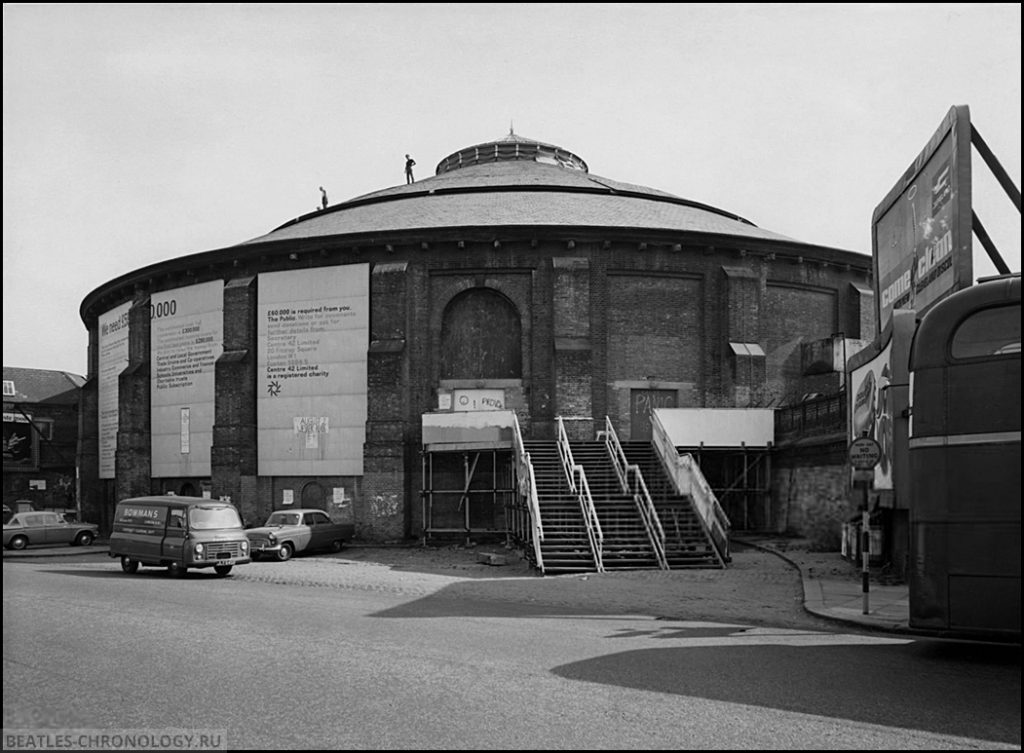
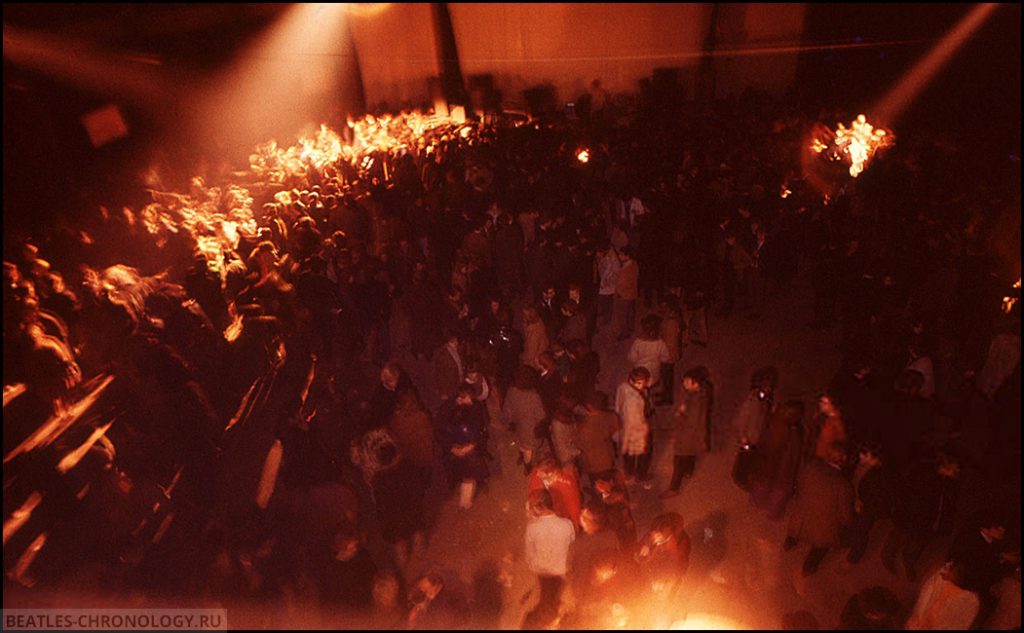
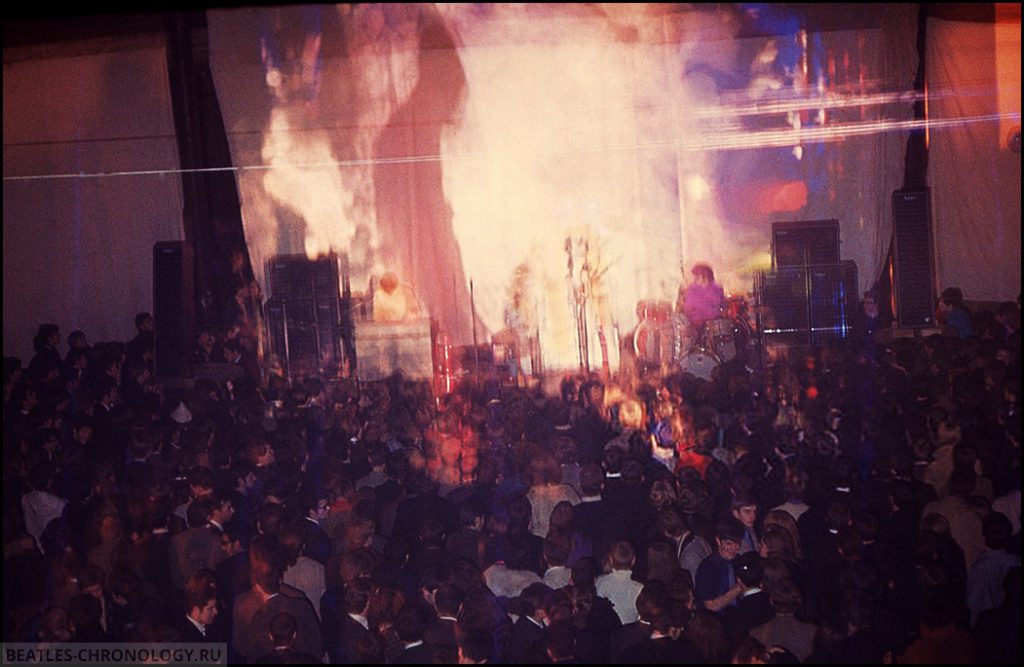
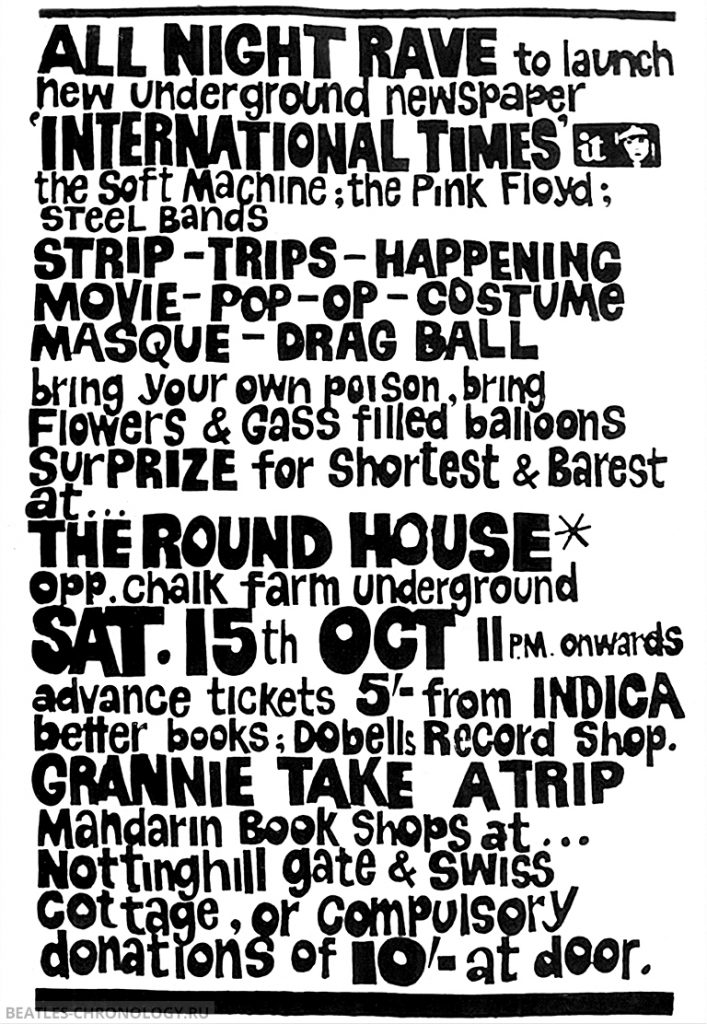
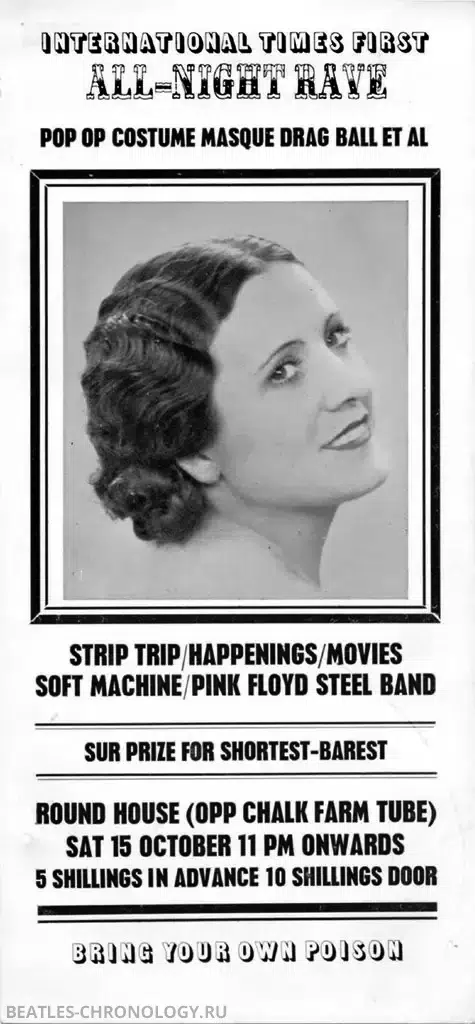
The Beatles Diary Volume 1: The Beatles Years
"With greatly expanded text, this is the most revealing and frank personal 30-year chronicle of the group ever written. Insider Barry Miles covers the Beatles story from childhood to the break-up of the group."
We owe a lot to Barry Miles for the creation of those pages, but you really have to buy this book to get all the details - a day to day chronology of what happened to the four Beatles during the Beatles years!

Notice any inaccuracies on this page? Have additional insights or ideas for new content? Or just want to share your thoughts? We value your feedback! Please use the form below to get in touch with us.